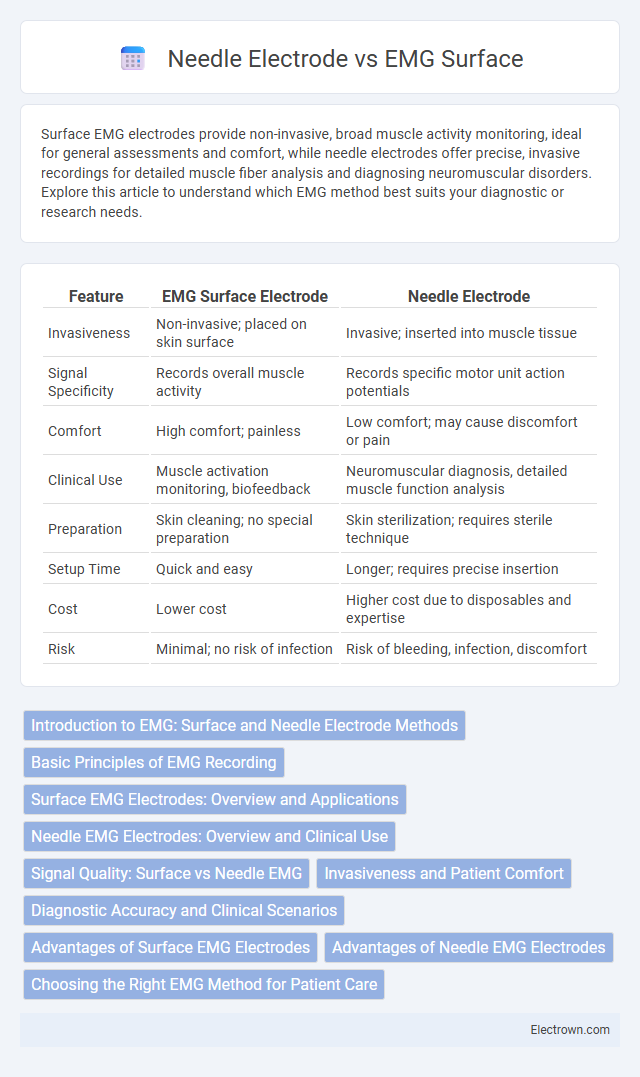Surface EMG electrodes provide non-invasive, broad muscle activity monitoring, ideal for general assessments and comfort, while needle electrodes offer precise, invasive recordings for detailed muscle fiber analysis and diagnosing neuromuscular disorders. Explore this article to understand which EMG method best suits your diagnostic or research needs.
Table of Comparison
| Feature | EMG Surface Electrode | Needle Electrode |
|---|---|---|
| Invasiveness | Non-invasive; placed on skin surface | Invasive; inserted into muscle tissue |
| Signal Specificity | Records overall muscle activity | Records specific motor unit action potentials |
| Comfort | High comfort; painless | Low comfort; may cause discomfort or pain |
| Clinical Use | Muscle activation monitoring, biofeedback | Neuromuscular diagnosis, detailed muscle function analysis |
| Preparation | Skin cleaning; no special preparation | Skin sterilization; requires sterile technique |
| Setup Time | Quick and easy | Longer; requires precise insertion |
| Cost | Lower cost | Higher cost due to disposables and expertise |
| Risk | Minimal; no risk of infection | Risk of bleeding, infection, discomfort |
Introduction to EMG: Surface and Needle Electrode Methods
Electromyography (EMG) measures muscle electrical activity through surface and needle electrodes, each serving distinct diagnostic purposes. Surface EMG uses non-invasive electrodes placed on the skin to detect overall muscle activity and is ideal for evaluating larger muscle groups and repetitive movements. Needle EMG involves inserting fine wire electrodes directly into muscle tissue, providing precise, localized readings critical for diagnosing neuromuscular disorders and assessing muscle fiber function.
Basic Principles of EMG Recording
Surface EMG electrodes detect electrical activity generated by muscles through sensors placed on the skin, offering non-invasive recording of muscle activation patterns. Needle electrodes penetrate the skin and muscle tissue to measure electrical signals at a deeper, more localized level, providing precise data on individual motor unit action potentials. Both methods rely on detecting voltage changes caused by muscle fiber depolarization, but differ in spatial resolution, invasiveness, and specificity of the recorded signals.
Surface EMG Electrodes: Overview and Applications
Surface EMG electrodes provide a non-invasive method to measure muscle electrical activity by detecting signals through the skin, making them ideal for monitoring larger muscle groups. These electrodes are commonly used in rehabilitation, sports science, and ergonomic assessments due to their ease of application and ability to capture real-time muscle responses during movement. Your analysis can benefit from their ability to offer continuous, painless recordings without the discomfort associated with needle electrodes.
Needle EMG Electrodes: Overview and Clinical Use
Needle EMG electrodes consist of fine, sterile needles inserted directly into muscle tissue to record electrical activity with high specificity and sensitivity. Commonly used in diagnosing neuromuscular disorders such as amyotrophic lateral sclerosis (ALS), peripheral neuropathies, and myopathies, needle EMG provides detailed information about motor unit action potentials and muscle fiber recruitment patterns. Their use requires trained clinicians and is vital for assessing muscle and nerve function in both clinical and research settings.
Signal Quality: Surface vs Needle EMG
Needle EMG provides higher signal quality with superior specificity and less interference, capturing activity from individual motor units deep within muscles. Surface EMG electrodes, while non-invasive and easier to apply, often pick up mixed signals from multiple muscles and are more susceptible to noise and motion artifacts. The choice between surface and needle EMG hinges on the need for precision versus ease of use and patient comfort.
Invasiveness and Patient Comfort
Surface EMG electrodes are non-invasive and placed on the skin, providing higher patient comfort by avoiding pain or discomfort during the procedure. Needle EMG electrodes penetrate the skin and muscle tissue, causing mild discomfort or pain, which may lead to increased patient anxiety. The less invasive nature of surface electrodes makes them suitable for repeated measurements and patients sensitive to pain.
Diagnostic Accuracy and Clinical Scenarios
Surface EMG electrodes provide non-invasive recording by detecting muscle electrical activity through the skin, offering ease of use and patient comfort but may have lower diagnostic accuracy due to signal crosstalk from adjacent muscles. Needle EMG electrodes penetrate the muscle tissue, allowing for precise localization and more accurate assessment of muscle function and neuromuscular disorders, making them ideal for detailed diagnosis in clinical scenarios such as neuropathies, myopathies, and motor neuron diseases. Your choice between surface and needle EMG should consider the diagnostic needs, patient tolerance, and the specific clinical context to optimize accuracy and effectiveness.
Advantages of Surface EMG Electrodes
Surface EMG electrodes offer a non-invasive method for monitoring muscle activity with minimal discomfort, making them ideal for repeated or long-term use. They provide valuable spatial information by covering larger muscle areas, enhancing the detection of muscle activation patterns compared to needle electrodes. Your choice of surface EMG electrodes supports safer, more accessible muscle assessments, especially in clinical or rehabilitation settings.
Advantages of Needle EMG Electrodes
Needle EMG electrodes provide precise detection of muscle activity by directly measuring electrical signals from within the muscle tissue, allowing for accurate diagnosis of neuromuscular disorders. They offer high spatial resolution and sensitivity, enabling the differentiation of individual motor unit action potentials that surface electrodes cannot capture. This invasiveness facilitates detailed assessment of deep muscles and subtle abnormalities critical for clinical evaluation.
Choosing the Right EMG Method for Patient Care
Selecting the appropriate EMG method depends on the clinical context and patient comfort, where surface EMG offers a non-invasive approach ideal for monitoring muscle activity during rehabilitation or sports performance. Needle EMG, involving intramuscular electrode insertion, provides precise diagnostic data about muscle and nerve disorders but may cause discomfort and requires specialized expertise. Your choice should balance diagnostic accuracy with patient tolerance to ensure effective and personalized care.
EMG Surface vs Needle Electrode Infographic

 electrown.com
electrown.com